News Powerhouse Gives Pointers for Great Content
- Fahad H

- Mar 26, 2018
- 5 min read
What can marketers learn about content quality from a news outlet? Plenty, if that news outlet is Quartz. If you read my post
How to Grow Your Audience From Zero to Millions in Less Than Five Years, you know that Quartz (“a new kind of global business news outlet”) creates content that people “freaking love.”
Yes!! Freaking love it! And immiscible, what a delightful word!! — Jen Brass Jenkins (@chrliechaz) January 18, 2018
What would you give to have people freaking love your content?What would you give to have people freaking love your #content, asks @MarciaRJohnston? Click To Tweet
The pointers here come from a talk that Jay Lauf, co-president and publisher of Quartz, gave at Content Marketing World: Deconstructing Quartz (QZ.com): How One of the Most Popular Mobile Destinations Grows Audience, Extends Reach in Digital, and Creates a Superior Content Experience.
Here are a few things that Jay and his team do that give Quartz readers palpitations:
They base their stories on their audience’s obsessions.
They surface each story’s “Thing” (kernel of interest).
They nail their company’s voice.
Base stories on your audience’s obsessions
Does your content team base its stories on what your company wants to talk about? Or do you dig into topics your audience is obsessed with?
At Quartz, journalists don’t call their topic categories “beats,” as in a traditional newsroom. They use the term “obsessions.” The distinction goes deeper than semantics. From the beginning, this team has been choosing which stories to create based on their answer to this question: “What do we think are the obsessions of our target audience today?”
Quartz hires journalists who have the same obsessions as the readers Quartz wants to reach. “Every single piece of content on Quartz is somebody’s obsession,” Jay says. This approach “gives the content a greater chance to be engaged with, to be shared, to be a delightful thing.”Every piece of @qz #content is somebody’s obsession, says @jlauf. Click To Tweet
The labels in the screenshot below are what Jay calls “longitudinal obsessions” – categories that have remained part of the news app for a long time:
Future of finance
Language
Science of learning
“America First”
Glass
Fashion
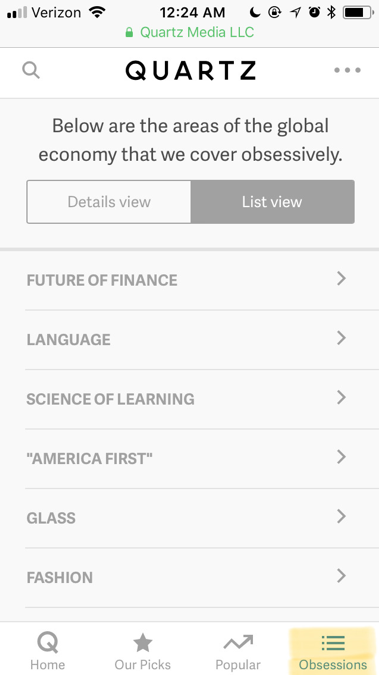
In addition, the Quartz team adds timely obsession categories, such as:
Modi-nomics (added during India’s 2014 general election)
Olympics (added … take a guess)
Bitcoin (added for six months during 2017)
Obsessions take other forms at Quartz. (It confused me at first that they use the term obsessions not only as a label for their news categories but also as a name for the weekday newsletter, which I talk about next.)
Last September, Quartz launched an interactive email newsletter called the Quartz Obsession. Each weekday, this newsletter delves into a topic a Quartz writer found fascinating (and thought the audience would too).
Here’s an example of an Obsession newsletter devoted to lava lamps:
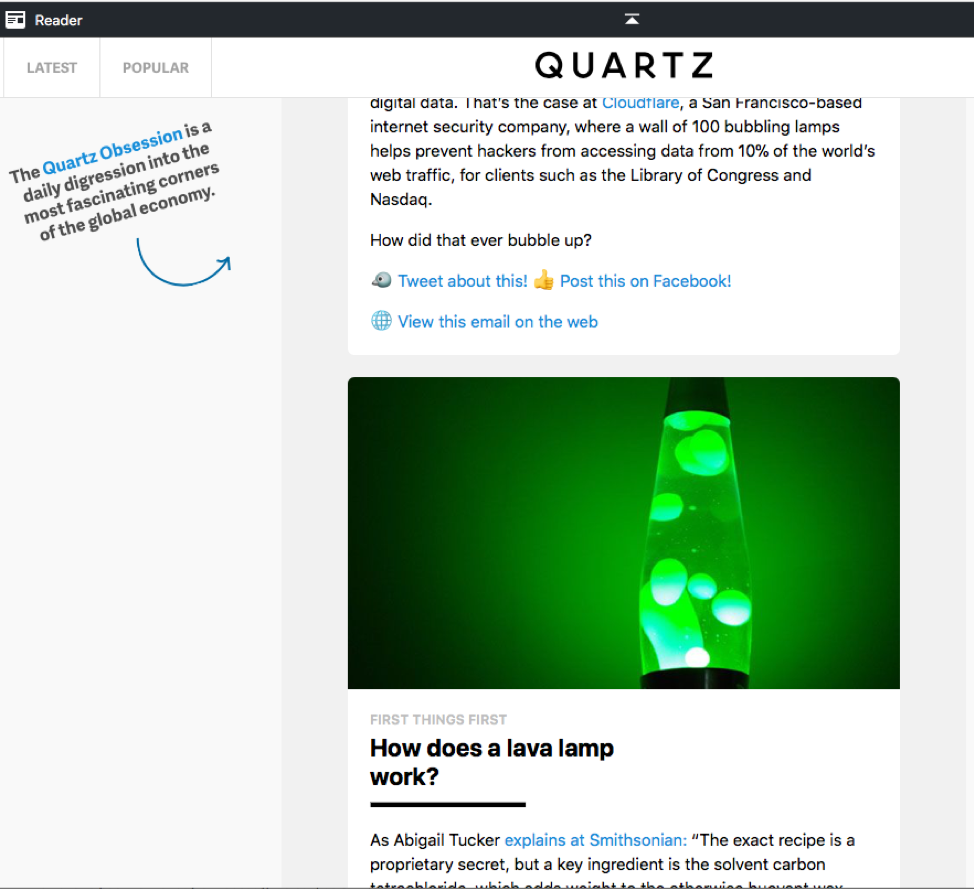
The newsletters inform and entertain, mixing stories and facts with GIFs, videos, quizzes, and polls. The writers have fun with language – asking in the lava lamp article, “How did that bubble up?” – while going deep and wide into their topics with a diligence and delight evident in only the most avid explorers.
What obsessed reader could resist a poll like this one, which appears at the end of the lava-lamp Obsession article?
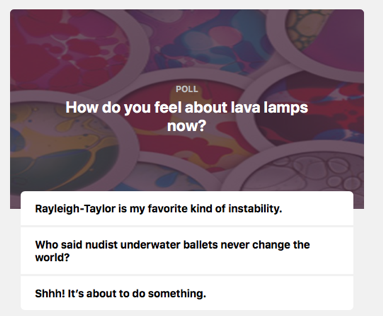
In case you get as big a kick out of this poll as I do, you’ll want to know which choice won. At the bottom of the next day’s Obsession, fans learned that the middle choice won: 36% of readers selected “Who said nudist underwater ballets never change the world?”
I can’t believe that the middle line beat out the clincher: “Shhh! It’s about to do something.” Genius.
“What are your target audiences obsessed with,” Jay asks. Focus your content on those areas and hire content creators who are obsessed with the same things.Hire #content creators who share your readers’ obsessions, says @jlauf. Click To Tweet
HANDPICKED RELATED CONTENT: How the Best Newsletters Get – and Keep – Readers’ Attention
Surface each story’s ‘Thing’ (kernel of interest)
As your team develops a story, are you satisfied with telling it straight? Or do you dig for a riveting nugget at the story’s core, something that others might never think to call attention to?
Quartz journalists are trained to find each story’s “Thing” – its kernel of interest – the thing worth putting in each headline. Here’s how Jay describes what they do:
We have a Things team … In any article or piece of content we put out, we look for the one Thing, the magic Thing that’s interesting about it, and we surface that.
Often, the writer will create a headline and craft a tweet or two before writing the article. If all a writer can come up with is boring (and prompts thoughts like “No one’s going to click on that. No one’s going to share it. No one’s going to like it,”), then the writer hasn’t yet uncovered the Thing – the kernel of interest – inside the story.
For example, in February 2016, other business news outlets were reporting Gap Inc.’s gloomy earnings report with headlines like this:
“Gap shares dip following disappointing earnings”
“Gap reports fourth-quarter earnings”
“Gap gives tepid forecast as it works on comeback.”
Who’s going to read those?
The Things team at Quartz came up with this headline: “Banana Republic made a blazer with armholes too small for an ‘average’ woman to get into.” (Banana Republic is one of the Gap brands.)
Inaccessible armholes?! Who isn’t going to read that article?
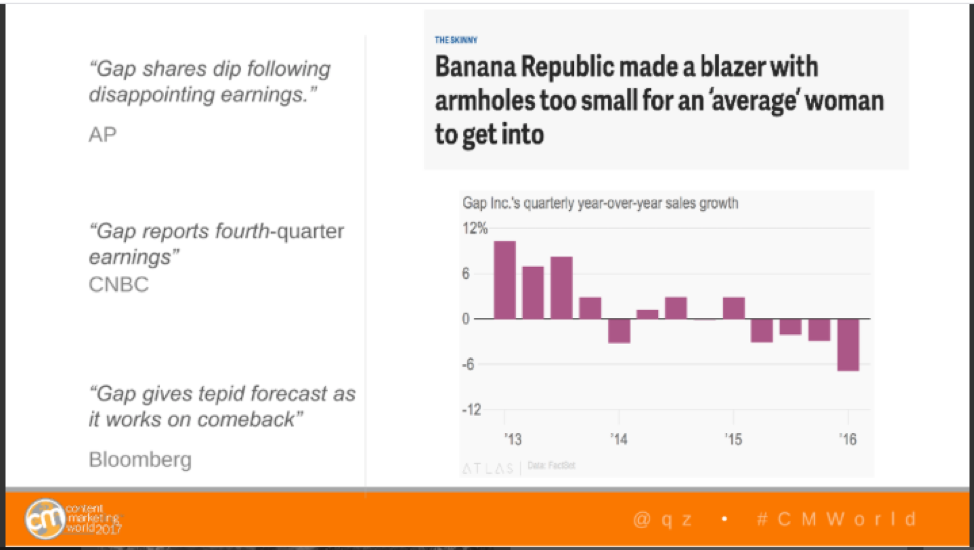
“The typical headlines from traditional news outlets don’t necessarily tell you anything,” Jay says. “They don’t draw you in.”
The thing about a story’s Thing is that it must be earned. You don’t just stick something in the headline to grab attention gratuitously. You do your homework.
In researching this story, the Quartz reporter discovered that Gap’s numbers were off partly because of Banana Republic’s performance. And one of the reasons Banana Republic’s performance was off was that its manufacturing and production had slipped.
“They had lost a ton of money in shipping blazers globally for women who couldn’t fit their arms in the armholes,” Jay says. “We surfaced that as the headline. That draws you in and makes the story more interesting, more shareable, more findable. Those are things we look for.”
HANDPICKED RELATED CONTENT: How the World’s Best Journalists Bring Interviews to Life
Nail your company’s voice
Another part of letting your content shine is getting the voice right for your audience and purpose.
As innovative as the Quartz team was in creating the world’s first app to deliver news instant-message style via chatbot, that inventiveness alone doesn’t explain why customers love the app. Customers love it (see Jay’s talk for testimonials) because of its conversational voice.
It’s the voice, Jay says, that “has made this thing magic, giving it a special way of engaging our audiences.”
Here’s a screenshot from the app that gives a sense of the Quartz voice:
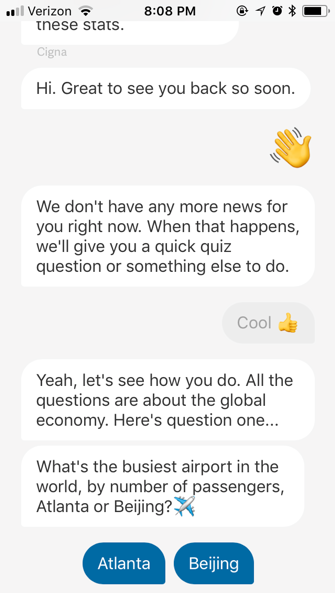
How many news sources say things like, “Great to see you back so soon,” and “Yeah, let’s see how you do”? How many news sources enable you to respond with a waving-hand emoji or a “cool”?
Jay isn’t suggesting everybody adopt a voice like this. Quartz understands its audience. Quartz aims for younger executives more than traditional media outlets do. The Quartz voice reflects the organization’s culture and the sensibility of the readers who keep coming back..@qz voice reflects its culture and the readers’ sensibility, says @jlauf. Click To Tweet
Jay’s advice to marketers: Whatever the personality of your company, “deploy it aggressively” in your content.
HANDPICKED RELATED CONTENT:
Conclusion
Does your team base its stories on your audience’s obsessions? Do you and your colleagues dig for each story’s unique kernel of interest and then bring that “Thing” to the headline? Have you nailed your company’s voice?
If so, you’re well on your way to a level of content performance that few companies experience. Tell us about it in a comment.
Get engaging insight and practical how-to advice from the 100-plus speakers at Content Marketing World Sept. 4-7 in Cleveland, Ohio. Register today and use the code BLOG100 to save $100.
Cover image by Joseph Kalinowski/Content Marketing Institute








Comments